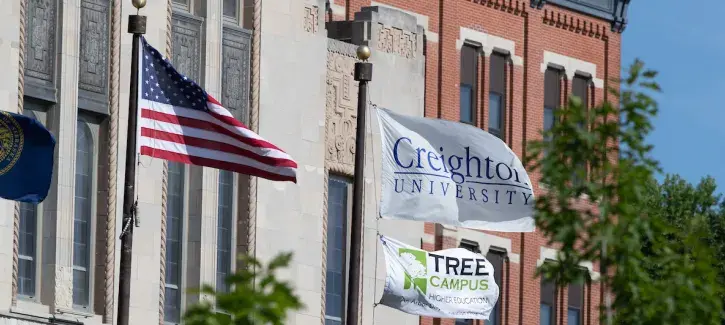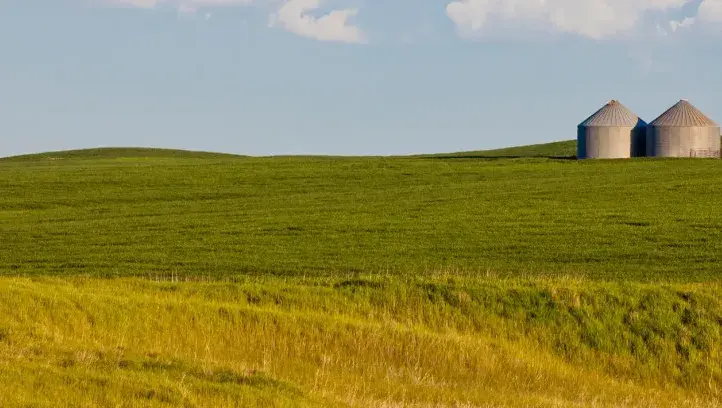
Tree Campus Higher Education flag flies on campus once again

Creighton University was honored with the 2024 Tree Campus Higher Education designation from the Arbor Day Foundation for its commitment to providing natural spaces and trees that benefit the environment and add to the health, vitality and beauty of campus.
“It’s a designation that shows that we put effort into the campus forest and its place in the urban canopy,” says Ebb Duis, landscape supervisor at Creighton. “When I got the final approval, it was the best day ever!”
Duis reflects the University’s commitment to sustainability, focusing her team's efforts on maintaining and implementing positive changes for the health and well-being of the campus environment and landscape.
15th Year for Designation
Duis says she is pleased that Creighton’s people show their care through action and participation and is thrilled to have the Tree Campus Higher Education designation back. The University has received the designation for the 15th year.
As a certified arborist, Duis’ job is to assess the health of every tree on campus. She looks at the trunks, the limbs, the canopies and the ground beneath the trees for signs of damage or problems.
“I just go through campus and make mental notes of what we need to address—pruning issues, trees that may be becoming hazardous, or potential spots for new trees, which is always fun,” she says.
In fact, Creighton planted four new trees as part of its 2024 Earth Month activities – two tuliptrees on the lawn outside the Kiewit Fitness Center and two London Planetrees outside the Hixson-Lied Science Building, in Anderson Plaza.
Andrew Baruth, PhD, director of the Office of Sustainability Programs, appreciates Duis’ work.
“I think one of the things she should be most proud of is that she updated our tree-care plan to be current and consistent with best practices,” he says. “It really spells out well how we can protect and preserve our campus forest. When trees must come down, it should be for things like disease or safety issues. If it has to do with campus planning—because we're doing some construction or renovation — it should be intentional.
“So now there’s a plan that, if a construction project is coming, there’s a radius that is set around certain trees to make sure they’re protected from root damage. If trees are diseased or damaged and need to come down, the plan helps us be thoughtful about replacing them. For example, do we replace them with the same species, or do we look at new Arboretum-style species to increase our campus biodiversity? Not being an arborist myself, I read that document, and I'm like, ‘Oh, this is amazing.’”
Baruth said he is particularly pleased with the plan's clarity and that Derek Scott, associate vice president for Facilities Management, has approved it. “That's our campus being sustainable, right? Sustainability is how we preserve and protect what we have so that future generations can enjoy it as much as we do.”
Good for Health
Both Baruth and Duis point out that having many trees, grass, flowers and bushes around campus is also notably good for the health and well-being of everyone on campus.
“It’s been researched and proven that having green spaces in an urban environment increases productivity and benefits mental health,” Duis says. “It gets people outside talking to people they usually wouldn’t and improves test scores.”
“I just always like to see trees on campus,” Baruth says. “It’s cleaning the air we breathe. It’s providing habitat so that we have some animals and insects on campus. It’s filtering the water before it goes in the storm sewers.”
In the summer of 2023, the University planted 95 trees — 30 by the CL and Rachel Werner Center for Health Sciences Education and 65 by Graves Hall. The University received a Tree Donor Grant last fall, and Duis worked with her team to plant another 35 trees across campus, focusing on those native to Nebraska. These included Hophornbeam, Black Gum, Japanese Silk Lilac, Downy Hawthorn, Serviceberry, Northern Catalpa, Swamp White Oak, Black Hills Spruce, Scarlet Red Oak, Little Leaf Linden, Kentucky Coffeetree, Honeylocust (thornless), and Purple Smokebushes.




